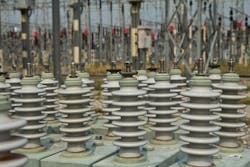An undervoltage or voltage sag is a disturbance that commonly occurs during electrical faults or when equipment is turning on. They are produced when large currents are being drawn on the system. On the opposite side of this spectrum are overvoltages or voltage swells. Typically, these events are less common than undervoltages but can still have the same negative effect on electronic equipment. A transient overvoltage disturbance can occur when an electric utility switches capacitors on the distribution system.
Electric utility capacitors provide voltage and VAR support. They allow power to be delivered efficiently from a substation to a facility. Facilities located miles from a substation may see low voltages on their system. This is due to impedance losses on the electric utility distribution circuit. Utility capacitors are an economical solution to boost the voltage near the end of a distribution circuit.
Some capacitors are fixed and do not switch on or off; others are automated and can switch the capacitors based on the needs of the utility system. This switching event creates transient overvoltages that may affect sensitive equipment in the facility. These transients occur within cycles and are so fast that facility personnel cannot visually perceive them with flickering lights. Nonetheless, they can still cause electronic equipment to misoperate. The electronics may pick up these transients and shut a system down due to the voltage peak reaching a high voltage threshold established by the equipment’s settings.
Placing an isolation transformer or line reactors in front of sensitive devices helps mitigate this situation. Most electronics have a filtering system that uses a TVSS or MOVs installed on the power stage, which helps clamp the voltages down to an operational level. However, these may not be sized sufficiently to handle this type of disturbance. Some utility capacitors are programmed to turn on in the morning and turn off at night. If there is a timely pattern to a facility’s equipment misoperating and there is no correlation with other equipment in the facility, then it may be beneficial to reach out to the utility engineer for assistance and review the utility’s capacitor settings.
